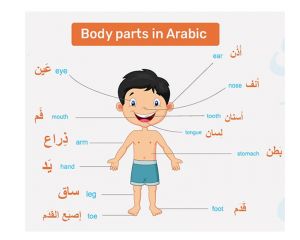Difference between revisions of "Language/Standard-arabic/Vocabulary/Parts-of-the-Body"
< Language | Standard-arabic | Vocabulary
Jump to navigation
Jump to search
| Line 1: | Line 1: | ||
<div class="pg_page_title">Body Parts in Arabic</div> | <div class="pg_page_title">Body Parts in Arabic</div> | ||
[[File:body-parts-in-arabic.jpg|thumb]] | [[File:body-parts-in-arabic.jpg|thumb]] | ||
Going to the doctor when visiting Morocco, Saudi Arabia or any other Arabic-speaking country is more common than you might think. This basic vocabulary in Arabic will help you to explain what you are suffering from or say where it hurts to the doctor. | Going to the doctor when visiting Morocco, Saudi Arabia or any other Arabic-speaking country is more common than you might think. This basic vocabulary in Arabic will help you to explain what you are suffering from or say where it hurts to the doctor. In this lesson, we will learn the names of some common body parts in Arabic. We will also explore some cultural insights related to these body parts. Here is a list of Arab words involving the body parts with English translation, transliteration & Arabic writing. | ||
In this lesson, we will learn the names of some common body parts in Arabic. We will also explore some cultural insights related to these body parts. | |||
Here is a list of Arab words involving the body parts with English translation, transliteration & Arabic writing. | |||
==Words in English & Arabic== | ==Words in English & Arabic== | ||
Revision as of 13:02, 11 March 2023
Body Parts in Arabic
Going to the doctor when visiting Morocco, Saudi Arabia or any other Arabic-speaking country is more common than you might think. This basic vocabulary in Arabic will help you to explain what you are suffering from or say where it hurts to the doctor. In this lesson, we will learn the names of some common body parts in Arabic. We will also explore some cultural insights related to these body parts. Here is a list of Arab words involving the body parts with English translation, transliteration & Arabic writing.
Words in English & Arabic
- The body is written الجسم (al-jism) in Arabic.
| English | Arabic (transliteration) | Arabic (writing) |
|---|---|---|
| The body | al-jism | الجسم |
| Ankle | kahil | كاحل |
| Arm | Dhirae | ذراع |
| Back | zahar | ظهر |
| Breast | sadr | صدر |
| Cheeks | Khdood | خدود |
| Chest | sadar | صدر |
| Chin | dhaqan | ذقن |
| Ear | Othon | اذن |
| Elbow | kue | كوع |
| Eye | ayn | عين |
| Eyebrow | alhajib | الحاجب |
| Eyes | Ain | عين |
| Face | Wajah | وجه |
| Finger | Al’iisbe | الإصبع |
| Fingernail | zufur | ظفر |
| Forehead | Jabiyn | جبين |
| Hair | Sh’ar | شعر |
| Hand | Yad | يد |
| Head | Ra’s | رأس |
| Hip | khasira | خاصرة |
| Jaw | fak | فك |
| Knee | Rakba | ركبة |
| Leg | Qadam | قدم |
| Lip | shifa | شفة |
| Mouth | Fam | فم |
| Nail | dhofr | ظفر |
| Neck | Raqabah | رقبه |
| Nose | Anf | أنف |
| Shoulder | kataf | كتف |
| Stomach | batan | بطن |
| Teeth | Asnan | أسنان |
| Thumb | ‘iibham | إبهام |
| Toe | ‘iisbae qadam | إصبع قدم |
| Tongue | lisan | لسان |
| Waist | wasat | وسط |
| Wrist | risgh | رسغ |
- رأس (ra's) - head The head is an important body part in Arabic culture. It is considered a symbol of intelligence and wisdom. It is also a sign of respect to touch or kiss someone on their forehead, as it shows reverence for their knowledge and wisdom.
- عين (‘ayn) - eye Eyes are seen as a window to the soul in Arabic culture. It is believed that they reveal a person's true intentions and emotions. It is considered rude to stare at someone for a long time in Arabic culture, as it can be seen as invasive.
- أذن (’udhun) - ear Ears are associated with listening and learning in Arabic culture. It is believed that one should listen carefully to others and take their advice. It is also considered rude to speak loudly in public places, as it can disturb others who are trying to listen or concentrate.
- فم (fam) - mouth The mouth is associated with speech in Arabic culture. It is believed that one should use their words wisely and avoid saying hurtful things to others. It is also important to keep the mouth clean and fresh, as bad breath can be seen as a sign of poor hygiene.
- يد (yad) - hand Hands are seen as a symbol of power and action in Arabic culture. It is considered disrespectful to touch someone with the left hand, as it is traditionally seen as the hand used for unclean tasks. The right hand is the preferred hand for shaking hands, giving gifts, and eating.
- قدم (qadam) - foot Feet are seen as a symbol of humility and respect in Arabic culture. It is customary to remove one's shoes before entering a mosque or someone's home. It is also considered impolite to show the soles of one's feet to others, as it is seen as a sign of disrespect.
Videos
Body Parts in Arabic
Arabic Language - Sentences Using Body Parts
Learn Arabic (Vocabulary) With Pictures
